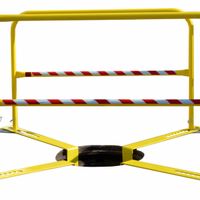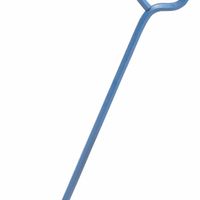Call +(254) 703 030 000 / 751 483 999 / 721 704 777
- Home
- Safety
- Confined Space
- Manhole Entry Retrieval Fall Prevention
.....Read More
Frequently Asked Questions
What are the best manhole entry and retrieval systems for safety?
The best manhole entry and retrieval systems prioritize safety, efficiency, and compliance with regulatory standards. Key systems include:
1. **Tripod Systems**: These are portable and easy to set up, providing a stable anchor point for confined space entry. They often come with a winch and fall arrest system, ensuring safe descent and ascent.
2. **Davits**: These systems offer flexibility and can be mounted permanently or temporarily. They allow for easy rotation and positioning over the manhole, facilitating safe entry and retrieval.
3. **Winches and Hoists**: Essential for controlled entry and exit, these devices are often used in conjunction with tripods or davits. They provide mechanical advantage, reducing the physical strain on workers.
4. **Self-Retracting Lifelines (SRLs)**: These devices automatically retract and extend, keeping the lifeline taut and reducing the risk of tripping or entanglement. They are crucial for fall protection.
5. **Harnesses**: Full-body harnesses are mandatory for workers entering manholes. They distribute the force of a fall across the body, minimizing injury risk.
6. **Gas Detection Systems**: Before entry, it's critical to monitor the atmosphere for hazardous gases. Portable gas detectors ensure the air is safe to breathe and alert workers to dangerous conditions.
7. **Communication Systems**: Reliable communication devices, such as radios or intercoms, are vital for maintaining contact between workers inside the manhole and those outside.
8. **Training and Procedures**: Comprehensive training on equipment use and emergency procedures is essential for ensuring worker safety during manhole entry and retrieval.
These systems, when used together, create a robust safety framework for manhole operations, protecting workers from potential hazards associated with confined spaces.
How do manhole guardrails prevent falls?
Manhole guardrails prevent falls by providing a physical barrier around the open manhole, thereby reducing the risk of accidental entry or falls. These guardrails are typically made of durable materials like steel or aluminum, ensuring they can withstand environmental conditions and provide reliable protection.
The design of manhole guardrails includes vertical posts and horizontal bars that create a secure perimeter around the manhole opening. This structure serves as a visual and physical warning to pedestrians and workers, alerting them to the presence of a potential hazard. The height of the guardrails is usually sufficient to prevent individuals from inadvertently stepping into the open manhole, while the spacing between the bars is designed to prevent slipping through.
Additionally, manhole guardrails often come with features such as locking mechanisms or gates that can be opened and closed as needed. This allows for controlled access to the manhole, ensuring that only authorized personnel can enter the area. The presence of a gate also helps maintain the integrity of the barrier when the manhole is not in use.
In many cases, guardrails are equipped with reflective materials or bright colors to enhance visibility, especially in low-light conditions. This further reduces the risk of falls by ensuring that the manhole is easily noticeable from a distance.
Overall, manhole guardrails are an essential safety measure in urban and industrial environments, effectively preventing falls by combining physical barriers, visual warnings, and controlled access features.
What is the function of a manhole guardrail winch?
A manhole guardrail winch serves multiple critical functions in ensuring safety and efficiency during operations involving manholes. Primarily, it acts as a protective barrier around the open manhole, preventing accidental falls and providing a secure perimeter for workers. The guardrail is typically constructed from durable materials like steel or aluminum, ensuring stability and resistance to environmental conditions.
The winch component of the system is integral for facilitating the safe and controlled lowering and raising of equipment, tools, or personnel into and out of the manhole. This is particularly important in confined space operations, where the risk of injury is heightened. The winch is equipped with a manual or powered mechanism that allows for precise control over the movement of loads, reducing the physical strain on workers and minimizing the risk of accidents.
Additionally, the manhole guardrail winch often includes features such as adjustable height settings and collapsible designs for easy transport and setup. This adaptability ensures that the system can be used in various environments and manhole sizes, enhancing its utility across different job sites.
In summary, the manhole guardrail winch is a vital safety and operational tool in industries that require access to underground utilities. It provides a secure barrier to prevent falls, facilitates the safe handling of equipment and personnel, and enhances overall efficiency in confined space operations.
How do shelters, umbrellas, and shields protect workers during manhole access?
Shelters, umbrellas, and shields are essential safety tools for workers accessing manholes, providing protection from environmental and operational hazards.
Shelters offer a controlled environment, shielding workers from adverse weather conditions such as rain, snow, or extreme heat, which can lead to hypothermia, heat exhaustion, or dehydration. By maintaining a stable internal climate, shelters help ensure that workers remain focused and efficient, reducing the risk of accidents due to environmental stress.
Umbrellas serve as portable, flexible protection against sun and rain. They prevent direct exposure to UV rays, reducing the risk of sunburn and heat-related illnesses. In rainy conditions, umbrellas keep workers dry, maintaining visibility and reducing the risk of slips and falls. Their portability allows for quick deployment and repositioning, ensuring continuous protection as work progresses.
Shields are critical for safeguarding against physical hazards. They act as barriers against falling debris, tools, or equipment, which can cause serious injuries. Shields also protect against vehicular traffic in urban settings, ensuring a safe perimeter around the work area. Additionally, they can be used to contain hazardous gases or fumes that may be released during manhole access, preventing inhalation and potential health risks.
Together, these protective measures enhance worker safety by mitigating environmental and operational risks, ensuring compliance with safety regulations, and promoting a secure and efficient work environment.
What are the advantages of using manhole dollies for lifting covers?
Manhole dollies offer several advantages for lifting covers:
1. **Safety**: They reduce the risk of injury by minimizing the need for manual lifting, which can lead to back strain or other musculoskeletal injuries. The dolly provides a mechanical advantage, allowing workers to lift heavy covers with less physical effort.
2. **Efficiency**: Manhole dollies streamline the process of removing and replacing covers, saving time and labor. This efficiency is particularly beneficial in urban areas where multiple manholes may need to be accessed in a short period.
3. **Versatility**: Many dollies are adjustable and can accommodate various sizes and types of manhole covers, making them suitable for different applications and environments.
4. **Durability**: Constructed from robust materials, manhole dollies are designed to withstand harsh working conditions and repeated use, ensuring long-term reliability and performance.
5. **Ergonomics**: The design of manhole dollies often includes features like handles and wheels that are ergonomically positioned to reduce strain on the user, promoting better posture and reducing fatigue.
6. **Cost-Effectiveness**: By reducing the risk of injury and increasing efficiency, manhole dollies can lead to cost savings in terms of reduced medical expenses, lower insurance premiums, and decreased downtime.
7. **Accessibility**: They enable easier access to manholes in confined or awkward spaces where traditional lifting methods might be challenging or unsafe.
8. **Compliance**: Using manhole dollies can help organizations comply with occupational health and safety regulations by providing a safer method for lifting heavy objects.
Overall, manhole dollies enhance safety, efficiency, and ergonomics, making them a valuable tool for workers who frequently handle manhole covers.
How do manhole lifters and hooks work for manual cover removal?
Manhole lifters and hooks are specialized tools designed to safely and efficiently remove and replace manhole covers. These covers are typically heavy, made of cast iron or concrete, and can weigh between 100 to 300 pounds or more. The tools work by providing leverage and grip, minimizing the physical strain on workers and reducing the risk of injury.
Manhole hooks are simple, sturdy tools with a long handle and a hook or claw at the end. The hook is inserted into a hole or slot on the manhole cover. By pulling back on the handle, the worker can lift the cover using leverage. The long handle allows the worker to stand at a safe distance, reducing the risk of injury from bending or lifting heavy weights directly.
Manhole lifters, on the other hand, are more sophisticated devices that often use mechanical or hydraulic systems to lift covers. They can be manual or powered. Manual lifters use a lever system where the worker applies force to a handle, which is then amplified through a series of levers to lift the cover. Powered lifters might use electric or hydraulic power to lift the cover with minimal human effort. These devices often have wheels or a dolly system to move the cover aside once lifted.
Both tools are designed to grip the cover securely, preventing slippage. They are essential for maintenance workers who need to access underground utilities safely and efficiently. Proper use of these tools not only enhances safety but also improves productivity by reducing the time and effort required to remove and replace manhole covers.
What safety standards should be followed for manhole entry and fall prevention?
For manhole entry and fall prevention, adhere to the following safety standards:
1. **Permit-Required Confined Space Program**: Implement a program that includes identifying hazards, testing the atmosphere, and ensuring proper ventilation. Issue entry permits detailing safety measures and authorized personnel.
2. **Atmospheric Testing**: Before entry, test for oxygen levels (19.5% to 23.5%), flammable gases, and toxic substances. Continuously monitor the atmosphere during occupancy.
3. **Ventilation**: Use mechanical ventilation to maintain safe atmospheric conditions. Ensure proper airflow to prevent accumulation of hazardous gases.
4. **Personal Protective Equipment (PPE)**: Equip workers with appropriate PPE, including helmets, gloves, eye protection, and respiratory protection if necessary.
5. **Fall Protection**: Use guardrails, barriers, or covers to prevent falls into open manholes. Employ harnesses and lifelines for workers entering the space.
6. **Entry and Exit Procedures**: Ensure safe access with ladders or steps. Maintain clear communication between entrants and attendants.
7. **Attendant Presence**: Station a trained attendant outside the manhole to monitor conditions and communicate with entrants. The attendant should not enter the space unless relieved by another trained individual.
8. **Emergency Preparedness**: Develop and practice rescue plans. Ensure rescue equipment is readily available and personnel are trained in its use.
9. **Training**: Provide comprehensive training for all workers involved in manhole entry, covering hazard recognition, equipment use, and emergency procedures.
10. **Signage and Barricades**: Clearly mark and barricade the area around the manhole to prevent unauthorized access and alert others to the potential hazard.
11. **Communication**: Establish reliable communication methods between workers inside the manhole and those outside to ensure quick response in case of emergencies.
By following these standards, you can significantly reduce the risks associated with manhole entry and ensure worker safety.




